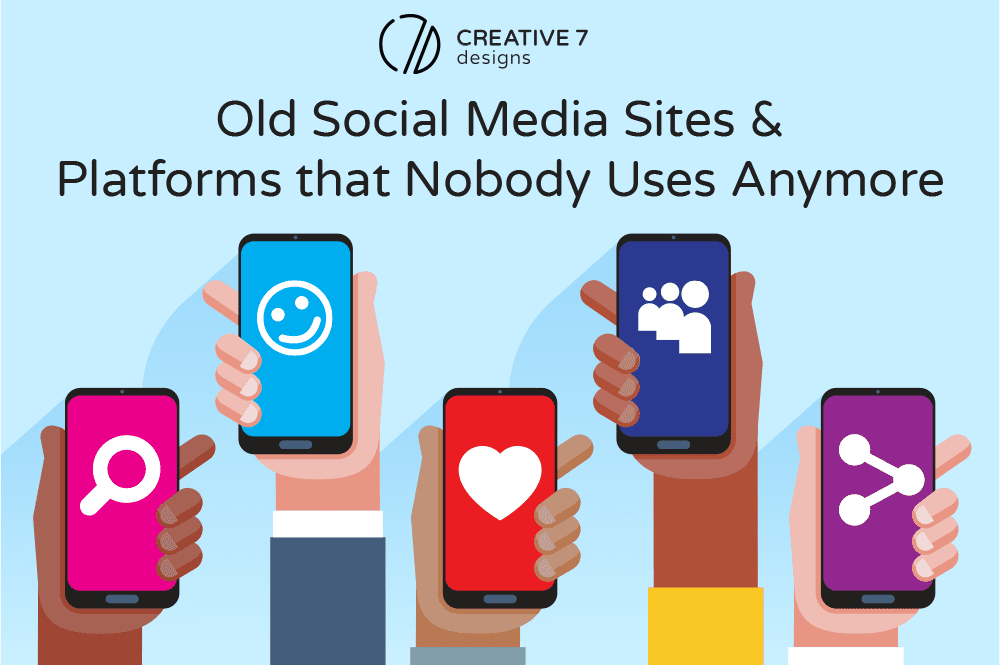Overview: Put on your nostalgia caps! In the era of Instagram, TikTok and YouTube, this list of old social media sites will give us a blast from the past
What old social media platforms did we use to “be social” before our current ones? There’s no doubt that social media plays a massive role in transforming lives, businesses, and the like – not just in one city or country, but across the globe. Marketing has evolved, and we can literally communicate with anyone in any corner of the world in a matter of seconds. Good riddance, handwritten letters! If you’ve ever wondered what happened to them, we’re considering some of the most used social media networks from the past today.
10 OLD SOCIAL MEDIA PLATFORMS:
The increasingly competitive market industry has closed the doors to some previously popular social media platforms, so we’ve compiled a list of popular but old social media platforms to fill us with nostalgia (and to send us the friendly reminder that forever is a myth).
Here are 10 social media sites that have faded with time. Though we miss them immensely at times, we recognize this comes with life’s process of being here one day and gone the next. (We promise this is as existential as we’re going to get in this article!)
1. DailyBooth:
Following the launch of DailyBooth in 2009, the application gained massive attention for the features it offered. DailyBooth users were encouraged to take a photo, post it with a caption, and share with the world how you’re doing – yes, basically Instagram before Instagram was Instagram.
DailyBooth became popular within 6 months after the launch with 3 million photos/posts and 6 million comments. However, it shutdown in 2012. And this is how the death of one gave birth to another!
In an article posted by The Mary Sue, the demise of DailyBooth stems from the fact that “the sharing of photos is something that happens in a million different places across the web,” so with everyone flocking to Instagram, “DailyBooth had long since ceased to be relevant.”
And guess what? We can assume that whatever platform it is that’ll eventually kill Instagram is surely coming — if not already arrived.
>> Related Reading: Is Dailybooth, THE original Web photo sharing service, closing down? (Update: Yes)
2. Yahoo Messenger:
Yahoo Messenger was it for a lot of us, from SMS messages to folder customization to vast storage space.
According to Yahoo, they ended Yahoo Messenger to divert time and resources to other communication tools: As the communications landscape continues to change, we’re focused on building and introducing new, exciting communications tools that better fit consumer needs.
>> Continue Reading: What Was Yahoo Messenger?
However, the modern Giants such as WhatsApp, Facebook, and the arrival of smartphones also contributed to the death of this platform – it couldn’t compete with the emerging social media sites and users switching to other platforms.
3. Yik Yak:
Interestingly, Yik Yak was launched in 2013 and relaunched in 2021. Nonetheless, we’re still adding it to the list because, if we’re being real, it simply lost it’s traction.
The old social media website was founded in 2013 and was popular among high-school and college students; it allowed users to create anonymous, localized posts (known as “yaks”) that can be seen by other users within a five-mile radius.
However, it soon turned into a breeding ground for hate speech, discrimination, cyberbullying, and even terrorist attacks were discussed – all disguised within its hidden messaging app that originally marked its popularity after its launch in 2014. The results? It was shut down in April 2017 after a series of campus controversies involving bullying and racist threats.
Although the company tried to curb the slur behind the closed door, it was shut from the operation.
So, what can we expect from its relaunch? According to Inside Higher Ed, a new generation of college students have apparently discovered the app. Some have no idea of its past history of cyberbullying and threats — which might favor the app.
The dangers that previously caused the app’s downfall are still very present, though, as some students are already seeing the dangers such as misinformation and gossip. We suppose only time will tell with this one.
4. Friendster:
As the name suggests, Friendster was an old social media application dedicated to developing friendships and stay connected. In 2003, when memes weren’t the primary source of connecting people, people were bound together through strings of photos.
However, Friendster had some technical issues and Facebook took that as an opportuniy to secure the momentum: The owner of Friendster approached Mark Zuckerburg with an acquisition deal which he refused. But Mark later bought the entire portfolio for $40 million and enhanced the features to create a user-friendly experience. It didn’t last, though, and was ultimately shut down in June 2015.
The causes of failure wa issues wit site performance , rising competition, executive turnover, as well as extensive content moderation.
5. Meerkat:
Meerkat, an innovative live-streaming app, was the first of its own to top up all the social feeds – faced its doom by the big social media giants, mainly Facebook and Twitter.
6. Friends Reunited:
Was that a place where the alumnae could gather and share their memories? We think it was – Friends Reunited was launched in 2000, years ahead of Facebook and other social media sites. However, it also couldn’t keep up with Facebook and Instagram, and Steve Pankhurst (the owner of Friends Reunited) shut it down with a heavy heart.
7. Habbo:
And last but not least, we shouldn’t forget Habbo – an old fellow that deserves to be on the list for the countless services it gave over the year. It was a fun online community with pixelated cartoon characters that could meet others in a public room and make a private room for selected friends – all that online.
Most of the users were 13-18 years old, and it is still used in some countries around the globe.
8. Pheed:
Launched in 2012 to share texts, photos, and videos just like the other social media sites. Pheed topped the App Store charts on social networking sites in only a year. However, the fame was short-lived, and it couldn’t maintain long-term momentum. In March 2014, American Movil bought Pheed, but it closed its door to the users in 2016.
9. MySpace:
Relax, Relax, MySpace still exists!! With a working URL and an office with employees to deal with any technical mishap, you can sign up for a new account right now. However, we included it here because it doesn’t work the same anymore.
MySpace helped shape what we today call – digital marketing. The role of MySpace is that of a grandparent who sees their children growing while they stay aside.
From the most visited website in 2006 to losing 11 million precious users in a single month. But the elders don’t lose hope, do they? – MySpace reinvented itself and dedicated its services as a music-focused network to help new artists rise.
Despite all these changes, MySpace didn’t work with that either, and it keeps shooting itself in the foot.
10. Fotolog:
As the name suggests, Fotolog came intending to offer opportunities to professionals and photography lovers to share their work and form communities.
Several influential artists were introduced, bonds built, and relationships established that work even to date. Moreover, it was one of its own kind, encouraging people to come up and play an influencer role.
The motive behind Fotolog was to focus on prime quality and publishing one best photo with an excellent but short description. Fotolog was a platform with 5 million users in 2006, and the number increased to 33 million by 2013. Unfortunately, this growth didn’t help gain enough profits to support maintenance, so the project was ended.
In Summary:
It’s nostalgic to look back to the old things that people don’t use anymore. The history and evolution of social media sites will continue and see their early innovations live and the growth of new platforms.
Things we’re clinging to right now may fade with time, and surprisingly, we always get used to them. Moreover, just because we’re using other social sites now doesn’t mean that the old ones aren’t in our hearts.


